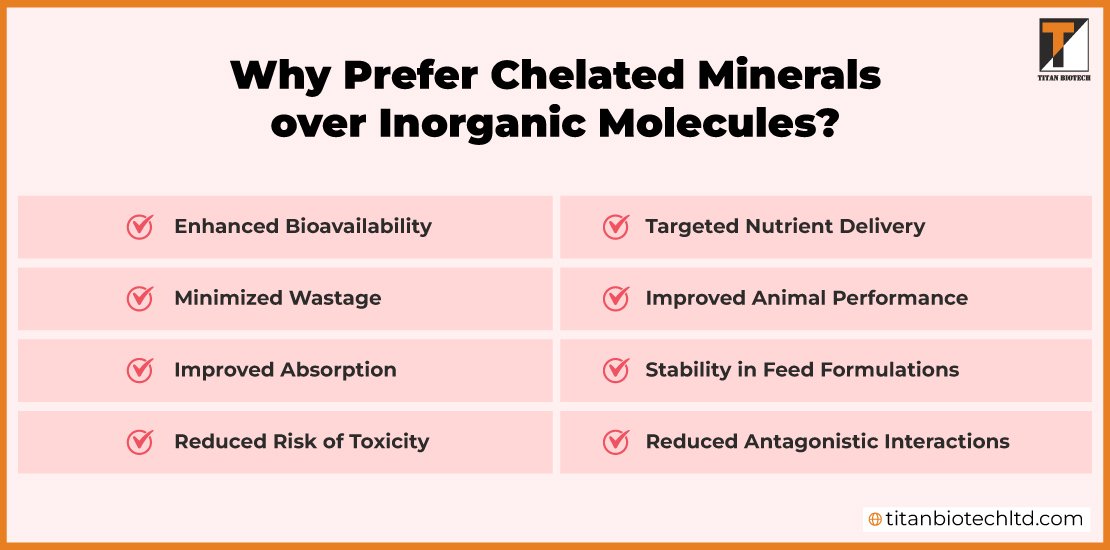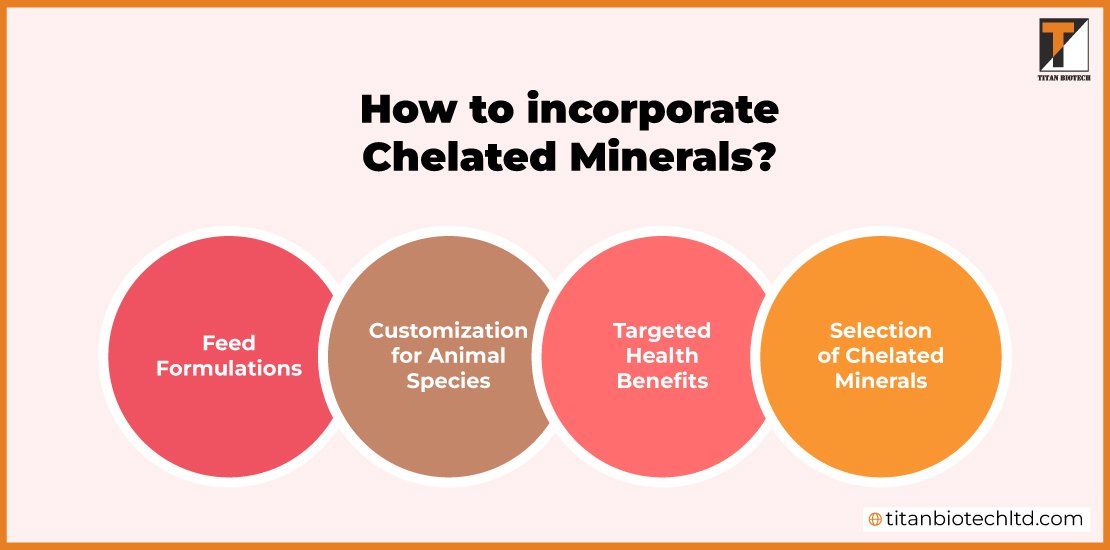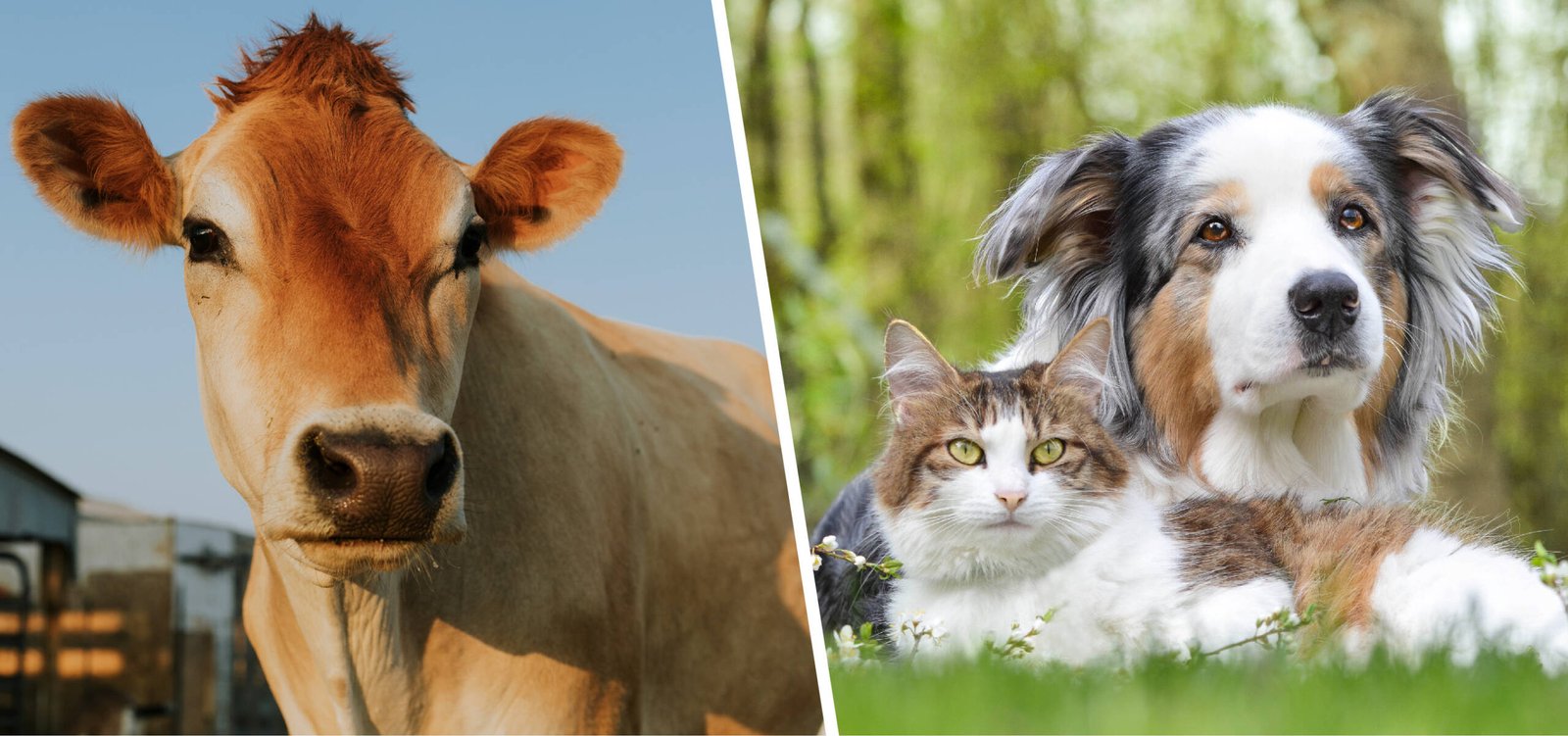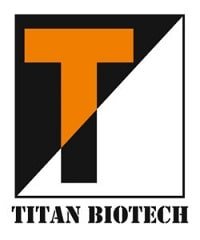Table of Content
- Importance of Chelated Minerals in Animal Nutrition
- Advantages of Chelated Minerals in Animals
- Why Prefer Chelated Minerals Over Inorganic Molecules?
- How to Incorporate Chelated Minerals?
- About Titan Biotech Limited
- Why Prefer Titan Biotech’s Chelated Minerals?
- Conclusion
- Frequently Asked Questions
- References
Chelated minerals are supplements that are chemically combined with organic molecules, such as amino acids, to form complexes. The process of chelation involves surrounding a mineral ion with these organic molecules, creating a stable structure. It results in a chelated mineral, where the mineral is bound to the organic molecules in a way that enhances its bioavailability and absorption in the animal’s digestive system.
Inorganic mineral supplements are often less bioavailable to animals because they may form insoluble compounds or interact with other dietary components, reducing absorption. Chelated minerals are designed to address these issues and provide a more efficient way for animals to absorb essential minerals. Common minerals often chelated for animal nutrition include Iron, Zinc, Copper, Manganese, Calcium, Magnesium, and Selenium.
Importance of Chelated Minerals in Animal Nutrition
Amino Acid Chelated minerals are commonly used in animal feed formulations, especially in livestock and poultry industries, to ensure that animals receive the necessary nutrients in a form that is easily absorbed and utilized by their bodies. The benefits of using chelated minerals in animal nutrition include increased bioavailability, improved nutrient utilization, and reduced risk of antagonistic interactions between minerals.
Farmers and animal nutritionists may choose chelated mineral supplements based on the specific needs of the animals and the desired outcomes, such as promoting growth, enhancing reproductive performance, or addressing specific health issues. Chelated minerals play a crucial role in optimizing the nutritional content of animal feed and ensuring that animals receive the essential minerals required for their overall health and well-being.
Advantages of Chelated Minerals in Animals

Chelated minerals can offer various benefits in the nutrition of different animal species, including poultry, ruminants, aquaculture species, and pets. Here are specific advantages in each category:
Poultry
- Improved Growth and Performance– Chelated minerals can enhance the bioavailability of essential minerals like zinc, copper, and manganese, leading to improved growth rates and overall performance in poultry.
- Bone Health– Chelated minerals such as calcium and phosphorus are crucial for bone development in poultry. Chelation can improve the absorption of these minerals, supporting skeletal health and reducing the risk of skeletal disorders.
- Immune System Support– Certain chelated minerals, such as zinc and selenium, play a vital role in immune function. Enhanced bioavailability can contribute to a stronger immune response, reducing the susceptibility to diseases.
- Feather Quality– Chelated minerals for poultry may positively influence feather quality in poultry, contributing to improved plumage and better resistance to weather-related issues.
Ruminants (Cattle, Sheep, Goats)
- Hoof and Skin Health– Chelated minerals for cattle are commonly used to support hoof and skin health in ruminants. These minerals play a role in the synthesis of keratin, a protein important for hoof structure.
- Reproductive Performance– Chelated minerals like selenium and manganese can contribute to improved reproductive performance in ruminants, supporting fertility and reducing the risk of reproductive disorders.
- Milk Production– Improved bioavailability of chelated minerals for livestock can positively impact milk production in dairy animals, supporting lactation performance and the health of the offspring.
Aquaculture (Shrimps and Fishes)
- Growth and Feed Efficiency– Chelated minerals can enhance the growth and feed efficiency of aquaculture species, promoting better utilization of nutrients from the feed.
- Disease Resistance– Certain chelated minerals, such as selenium and zinc, contribute to the immune function of shrimp, fish, and shellfish, helping them resist diseases prevalent in aquaculture environments.
- Optimized Bone and Shell Development– Chelated calcium and phosphorus are crucial for bone development in fish and shellfish. Improved absorption can contribute to stronger skeletons and shells.
Pets (Dogs and Cats)
- Joint and Bone Health– Chelated minerals for pets, particularly calcium and phosphorus, can support joint and bone health, promoting overall mobility and reducing the risk of skeletal issues.
- Skin and Coat Quality– Chelated zinc and copper play a role in maintaining healthy skin and coat in pets. Improved absorption contributes to a shinier coat and reduced risk of skin problems.
- Immune System Support– Chelated minerals such as selenium and zinc support the immune system in pets, helping them resist infections and maintain overall health.
- Digestive Health– Chelated minerals for dogs & cats can contribute to better digestive health, ensuring optimal absorption of nutrients from their diet.
Chelated minerals benefits in different animal species are multifaceted, ranging from improved growth and reproductive performance to enhanced immune function and overall health. However, it’s important to tailor mineral supplementation to the specific needs and requirements of each animal species.
Why Prefer Chelated Minerals Over Inorganic Molecules?

Choosing chelated minerals over inorganic minerals in animal nutrition is often based on the desire to improve the bioavailability and effectiveness of the minerals provided to animals. Here are some reasons why chelated minerals are preferred:
- Enhanced Bioavailability– Chelated minerals have higher bioavailability compared to their inorganic counterparts. The chelation process protects minerals from interactions with other compounds in the digestive system, allowing for better absorption. This means that a larger proportion of the supplemented minerals is absorbed and utilized by the animal.
- Improved Absorption– Chelated minerals are more easily absorbed in the digestive tract. The organic molecules surrounding the mineral help facilitate transport across the intestinal membrane, leading to increased absorption into the bloodstream.
- Reduced Antagonistic Interactions– Inorganic minerals may compete with each other for absorption in the digestive system, leading to reduced overall bioavailability. Chelated minerals are less likely to interact negatively with each other, allowing for a more efficient absorption of individual minerals.
- Minimized Wastage– Chelated minerals for cattle can reduce mineral wastage because a higher percentage of the supplemented minerals is absorbed and utilized by the animal. This can be particularly important in terms of cost-effectiveness and environmental impact.
- Targeted Nutrient Delivery– Chelated minerals can be designed for specific functions within the animal’s body. For example, zinc and copper chelates are commonly used to support skin and hoof health in livestock. This targeted delivery allows for a more precise and effective supplementation strategy.
- Reduced Risk of Toxicity– Chelated minerals may have a lower risk of causing mineral toxicity. The chelation process helps regulate the release of minerals within the body, preventing excessive accumulation and reducing the risk of adverse effects associated with high mineral levels.
- Stability in Feed Formulations– Chelated minerals can be more stable in feed formulations, maintaining their integrity during processing and storage. This ensures that the mineral content in the animal feed remains consistent over time.
- Improved Animal Performance– The animals may experience better growth rates, reproductive performance, and overall health due to the increased bioavailability and improved absorption of chelated minerals. It leads to improved efficiency in production systems.
In chelated minerals vs inorganic minerals, chelated minerals supplements offer advantages in animal nutrition to supplement the diet of various species, including livestock, poultry, aquaculture species, and pets.
How to Incorporate Chelated Minerals?

The incorporation into animal feed is a common practice to ensure that animals receive essential minerals in a form that is highly bioavailable and easily absorbed. Here’s how chelated minerals are used in animals:
- Feed Formulations– Chelated minerals are added to animal feed formulations during the manufacturing process. These formulations can include supplements or premixes.
- Selection of Chelated Minerals– Animal nutritionists and veterinarians select specific chelated minerals based on the nutritional requirements of the target species. Common chelated minerals include zinc, copper, manganese, iron, calcium, selenium, and others.
- Customization for Animal Species– Chelated mineral formulations may be customized based on the specific nutritional needs of different animal species. For example, formulations for poultry may differ from those for ruminants or aquaculture species.
- Targeted Health Benefits– Chelated minerals can be selected to provide specific health benefits. For instance, zinc and copper chelates might be used to support skin and hoof health in livestock, while selenium chelates may be chosen to boost immune function.
Chelated minerals are used in animals by incorporating them into feed formulations to meet specific nutritional requirements, enhance bioavailability, and support overall health and performance. The precise application may vary based on the species, production goals, and environmental considerations.
About Titan Biotech Limited
Titan Biotech Limited, headquartered in Delhi, India, offers premium quality raw material ingredients to various sectors like animal nutrition, pharmaceutical, nutraceutical, cosmeceuticals, and food & beverages. We are a leading chelated minerals manufacturer and exporter with a strong market presence of more than 30 years.
We also manufacture collagen peptides, proteins, ox bile extract, food ingredients, yeast extract, cosmetic, and bone & joint care ingredients, among others, for various vital applications. We use our technical expertise to provide customers with high-grade products and services. The strong market presence enables us to identify local trends that help us collaborate with key industry players worldwide. We have state-of-the-art manufacturing facilities located in Bhiwadi, Rajasthan. The products are produced according to international quality standards: ISO and GMP.
Why Prefer Titan Biotech’s Chelated Minerals?
Chelated minerals, resulting from the chelation process where mineral ions are bound to organic molecules, possess several unique properties that contribute to their efficacy and benefits in various applications. Here are some reasons to prefer chelated minerals manufactured by Titan Biotech.
- Enhanced Bioavailability– One of the primary properties of chelated minerals is their increased bioavailability. The chelation process protects mineral ions from interactions with other compounds in the digestive system, allowing for more efficient absorption in animals.
- Stability– Chelated trace minerals in animal nutrition exhibit enhanced stability compared to inorganic forms. The chelate structure protects the minerals from forming insoluble compounds or undergoing unwanted reactions, maintaining their integrity during storage.
- Reduced Antagonistic Interactions– Chelation helps minimize antagonistic interactions between different minerals. Inorganic minerals may compete with each other for absorption in the digestive tract, leading to reduced overall bioavailability. Chelated minerals are less likely to interfere with each other, ensuring optimal absorption.
- Targeted Nutrient Delivery– Chelates can be designed with specific ligands to target particular tissues or functions within the body. This targeted nutrient delivery allows for a more precise supplementation strategy based on the animal’s specific needs.
- Controlled Release– The chelation process helps regulate the release of minerals within the animal’s body. This controlled release minimizes the risk of excessive accumulation and toxicity, particularly important for minerals with narrow safety margins.
- Solubility– Chelated minerals often exhibit improved solubility in comparison to their inorganic counterparts. This increased solubility can contribute to better dispersal and distribution of minerals in animal feed, promoting uniform nutrient content.
- Resistance to Precipitation– Chelation protects minerals from forming insoluble precipitates. This resistance to precipitation ensures that the minerals remain in a form that is more easily absorbed by the animal, contributing to their effectiveness as supplements.
Conclusion
Chelated minerals have emerged as a powerful tool in the realm of animal nutrition, offering enhanced bioavailability, improved absorption, and targeted delivery of essential minerals. From poultry and ruminants to aquaculture species and pets, the advantages of chelated minerals span across various animal categories. The chelated minerals dietary supplements allow nutritionists, veterinarians, and farmers to make informed decisions when incorporating chelated minerals into animal diets, ultimately optimizing the health, growth, and performance of the animals.
Frequently Asked Questions
What are chelated minerals, and how do they differ from inorganic minerals in animal nutrition?
Chelated minerals are mineral supplements bound to organic molecules for improved bioavailability. Chelated minerals are more easily absorbed by animals, enhancing their utilization and providing various health benefits.
What are the primary advantages of using chelated minerals in poultry nutrition?
Chelated minerals in poultry nutrition offer enhanced growth and performance, improved bone health, immune system support, and optimized feather quality. The chelation process contributes to increased bioavailability, benefiting overall poultry health and production.
How do chelated minerals contribute to hoof and skin health in ruminants?
Chelated minerals, particularly zinc and copper, play a crucial role in supporting hoof and skin health in ruminants. These minerals, when chelated, are more efficiently absorbed, promoting the synthesis of keratin for better hoof structure and overall skin condition.
What role do chelated minerals play in promoting reproductive performance in livestock?
Chelated minerals, such as selenium and manganese, can positively impact reproductive performance in livestock. Improved bioavailability supports fertility, reduces the risk of reproductive disorders, and improves overall herd or flock reproductive outcomes.
How are chelated minerals used in aquaculture to enhance growth and disease resistance in shrimp, fish, and shellfish?
Chelated minerals in aquaculture contribute to improved growth and feed efficiency in shrimps, fish, and shellfish. Additionally, certain chelated minerals, like selenium and zinc, support the immune system, helping these aquatic species resist diseases prevalent in aquaculture environments.
Can chelated minerals be beneficial for pets, and how do they contribute to their overall health?
Yes, chelated minerals benefit pets by supporting joint and bone health, promoting a shiny coat, and contributing to immune system function. Chelated minerals, when included in pet diets, enhance nutrient absorption, ensuring pets receive the essential minerals required for optimal health and well-being
References
- https://www.ijabbr.com/article_7939_d872a1bd16826957818632ae6e578e4e.pdf
- https://www.researchgate.net/publication/330087780_Chelated_minerals_and_its_effect_on_animal_production_A_review
- https://www.ncbi.nlm.nih.gov/pmc/articles/PMC10376876/

